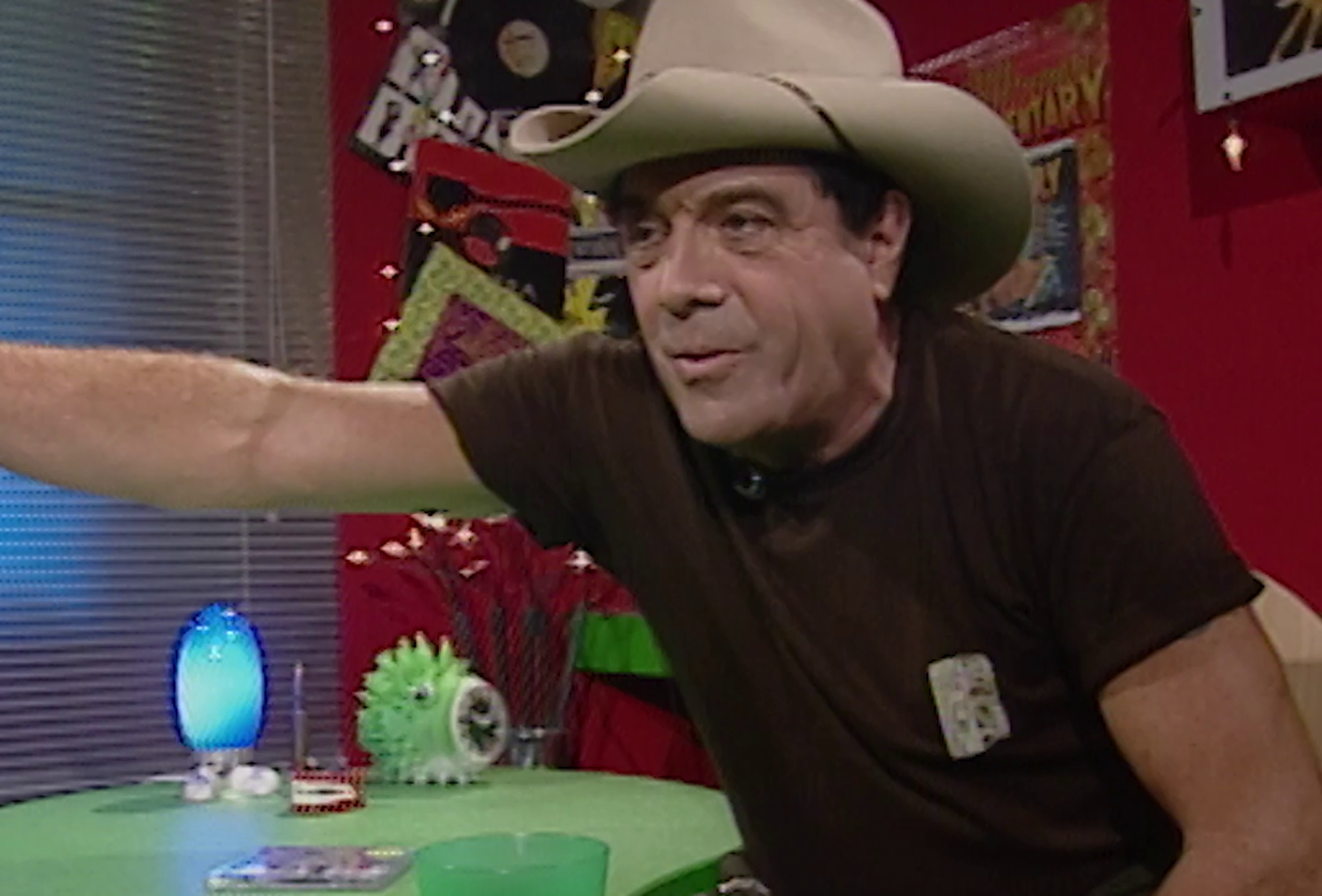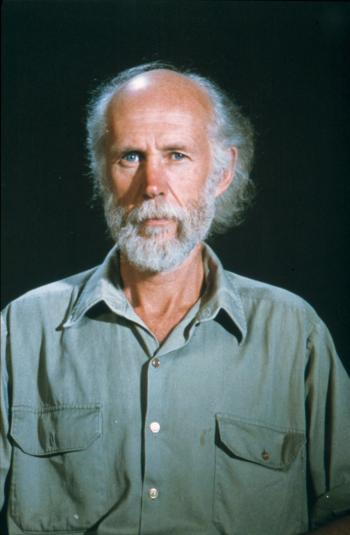BY MICHAEL LEIGH, TRISTAN COLE, TREVOR GRAHAM AND ROSE HESP


BY MICHAEL LEIGH, TRISTAN COLE, TREVOR GRAHAM AND ROSE HESP
WARNING: Aboriginal and Torres Strait Islander viewers are advised that the following program may contain images and/or audio of deceased persons.
Internationally renowned Australian documentary filmmaker Ian Dunlop OAM has passed away at age 93. Ian received the National Film and Sound Archive Award for Film Preservation in 2009 in acknowledgement of his major contribution to the preservation of films of Australian Indigenous communities through his own work and his preservation and protection of the work of others.
Below you'll find information about Ian's life and tributes from Tristan Cole of Kanyirninpa Jukurrpa, and filmmakers Trevor Graham and Rose Hesp. Ian has left an incredible legacy and will be greatly missed.
In an essay on the history of Australian ethnographic film published on the NFSA website, film archivist Michael Leigh writes:

'Ian Dunlop began making films at the Commonwealth Film Unit in the late 1950s. One of the client departments for the government film production agency was the Department of the Interior, who had responsibility for Aboriginal people in Commonwealth territories. Up to this point the Commonwealth Film Unit had used images of Aboriginal people as curiosities in gazettes and newsreels and at the end of lists enumerating the splendours of the Australian bush, just another wonder of nature like the platypus. Ian Dunlop changed all this. First seeing and filming nomadic Aboriginal people whilst making a documentary about the remote desert weather station at Giles in Western Australia, he was inspired to include the film study of Indigenous Australians in his life’s work.
Pressures fuelled by tourist development concerns and military needs, and the extension of bureaucratic control over formerly remote areas, saw round-ups of Aboriginal people and their removal from their lands to government camps and settlements such as Kintore, Papunya and Yuendumu. Dunlop came back from the Giles trip and arranged – with the Australian Institute of Aboriginal Studies (later AIATSIS) providing funding – to return in 1965 and 1967 to make ethnographic films. He filmed 5 families as they showed him various aspects of their life in the desert. This resulted in the publication of a 19-part series of films entitled People of the Australian Western Desert.
This series was widely shown and greeted with much acclaim. In 1967 Dunlop edited 3 parts of the series into a cinema release version called Desert People. This film went on to win even greater acclaim, including awards in Prades (France), Edinburgh, Padua, Australia, New York and Chicago. It was screened all over the world and for many people the images in it became their defining images of Aboriginal Australians.
Dunlop also promoted a greater understanding of earlier ethnographic film, overseeing the preservation and screening of Walter Baldwin Spencer’s films that then lay in disuse and neglect. He used this footage in screening programs around the world and lectured on the history of ethnographic film in Australia, building on the international impetus that resulted from the 1966 UNESCO conference.
Later in his career Dunlop concentrated his filming at Yirrkala in Arnhem Land and formed a close, collaborative relationship with the great painter, Narritjin Maymuru. This complex, extended ethnographic filmmaking project ultimately led to 22 public films (and one restricted film).
Tristan Cole, General Manager of Kanyirninpa Jukurrpa writes:
'It is with great sadness we have heard about the passing of Ian Dunlop.
In 1965 Ian travelled to a harsh and inhospitable part of the Western Desert to film a group of nomadic Martu Indigenous people who were still living on their own land, as they had done for millennia. The series of films known as People of the Australian Western Desert record everyday Martu life and have become an important record of traditional life. They are watched regularly by members of the Martu community. The films provide an important link for younger Martu to traditional knowledge, practices and culture. Martu working with Kanyirninpa Jukurrpa emulate many of these traditional practices while working on and looking after Martu country.
Ian was always very generous with his film and his time. He met with Martu elders and younger workers who were keen to hear about the Martu families Ian had filmed and about his time in the desert. Ian felt that it was important that the films be watched by younger generations of Martu to strengthen cultural practice and protect the desert environment.
Ian will be sadly missed.'
In this excerpt from the Film Australia Collection's Ceremony: The Djungguwan of Northeast Arnhem Land (2006), Ian and Marrakulu Elder Dundiwuy Wanambi talk about the importance of finding new ways to document Aboriginal culture:
Excerpt from the 2006 Film Australia National Interest Program DVD, Ceremony: The Djungguwan of Northeast Arnhem Land, produced in association with Denise Haslem Productions. Made in collaboration with Yirrkala Dhanbul Community Association and the Rirratjingu Association. NFSA: 715209
Filmmakers Trevor Graham and Rose Hesp, who worked with Ian on the Ceremony: The Djungguwan of Northeast Arnhem Land project, write:
'Australia lost a pioneering documentary filmmaker this week with the passing of Ian Dunlop in Canberra. A friend and colleague, Ian’s People of the Western Desert was a landmark in the history of international documentary.
I had the good fortune to meet Ian in the corridors of Film Australia in the mid-1990s when I was directing Mabo: Life of an Island Man with producer-editor Denise Haslem. Ian was collating and cataloguing his enormous collection of films and production stills so they could be archived. Some of his work was going to the National Archives of Australia and some to AIATSIS (the Australian Institute of Aboriginal and Torres Strait Islander Studies). We became good friends. My wife Rose Hesp and I would share many meals at Ian and Roey’s place on the edge of the bush in Gordon. Their beautiful mid-20th century minimalist wood-and-glass home housed a treasure trove of art works from Papua New Guinea and north-east Arnhem Land. We also shared with Ian and Roey a passion for Italian red wines.
In the early 2000s Ian Dunlop, Denise Haslem and I collaborated on a project together, Ceremony: The Djungguwan of Northeast Arnhem Land, produced in collaboration with, and at the request of, the Yirrkala Dhanbul Community Association and the Rirratjingu Association, for Film Australia.
Like a grand opera the ‘Djungguwan’ is an initiation ceremony of the Rirratjingu and Marrakula clans. It teaches young boys about discipline, law and respect for Yolngu traditions. A ceremony of transition, teaching and remembering, it can take weeks to stage and perform. The Yolngu’s Djungguwan has a unique place in Australian cinematic history: it’s been filmed in its entirety on 4 separate occasions.
In 1963 the Djungguwan ceremony was first documented on film by anthropologist Nic Peterson for AIATSIS. Ian Dunlop filmed the ceremony for Film Australia in 1976 with the great, then observational documentary DOP (Director of Photography), Dean Semler. Denise Haslem, Rose Hesp and myself similarly recorded the ceremony in 2002 in Yirrkala. In 2003 the ceremony was once again staged at Gurka’wuy and filmed by Kos Tambling.'
In the clip below, Ian talks about working with Dean Semler:
Excerpt from the 2006 Film Australia National Interest Program DVD, Ceremony: The Djungguwan of Northeast Arnhem Land, produced in association with Denise Haslem Productions. Made in collaboration with Yirrkala Dhanbul Community Association and the Rirratjingu Association. NFSA: 715209
Trevor and Rose continue:
'The result of our collaboration with Ian was a DVD set comprising a 3-hour version of the Djungguwan filmed by him in the mid-70s, and a 75-minute version directed by myself in 2002.
One of the great experiences Denise Haslem, Rose Hesp and I, along with our young daughter Angelita, had in our 10 months living and filming in north-east Arnhem Land was watching Ian Dunlop’s Yirrkala Film Project with the Yolngu. Filmed between 1970 and 1982, it comprises 22 films and runs for 1,271 minutes. Our living room became an impromptu theatrette as dozens of family members dropped by and stayed for hours transfixed by the intricate preparations and ritual dances flickering on our TV screen. Their reverence was sometimes punctuated by tears and hoots of laughter. Ian’s films may be a priceless record of the oldest continuous culture on Earth, but for the Yolngu they are also home movies in which parents, grandparents and extended clan members are lovingly remembered, immortalised on film performing one of their most important sacred rituals.
One of Ian’s closest Yolngu collaborators during his time at Yirrkala in the 1970s was Mithili Wanambi, an esteemed clan leader and artist. He instantly understood the importance of Ian’s work and fully embraced and supported his film project. Almost 30 years later, because of our friendship with Ian, we were welcomed by the Yolngu. He was a legendary figure in their eyes. He had documented their life at a time when Indigenous culture barely mattered to white Australia. He was loved and respected by their elders, and revered by their descendants. A friend of Ian’s was a friend of the Yolngu. Thus our consultant-translator became Mithili’s son, Wukun Wanambi. As the oldest male child of Ian’s lead consultant, Wukun adopted us into his family and his kinship line. We spent weeks and months with Wukun, and many, many hours with him and his family, watching Ian’s films as they pointed out relatives and explained the stages of the ceremony. Today Wukun is a highly acclaimed Arnhem Land painter, sculptor and video artist who uses his art to advocate for a true understanding of Aboriginal culture.
The Ceremony – Djungguwan DVDs were launched by Film Australia to mark UNESCO World Day for Audiovisual Heritage and presented to their collection in 2007. The documentaries featured in the set are cultural crown jewels: a priceless part of Australia’s heritage made with and for the Yolngu for future generations.
Ian Dunlop will never be as well-known as film directors like George Miller, Peter Weir or Gillian Armstrong, but he has left a legacy to Australia’s cultural and filmmaking heritage every bit as important, and one that may well stand the longer test of time.
As Wukun Wanambi says in the Ceremony Djungguwan, 'So this is now for the future generations. Dhuwa and Yirritja so that you can see this picture and remember what we are doing'.
Ian’s films will live on, but he will be greatly missed.'
You can view clips from the three Djungguwan Ceremony films in the Ceremony: The Djungguwan of Northeast Arnhem Land curated collection.
You can buy digital copies of many of Ian Dunlop's films, including the Yirrkala Film Project, Desert People and People of the Western Desert at the NFSA online shop.
The National Film and Sound Archive of Australia acknowledges Australia’s Aboriginal and Torres Strait Islander peoples as the Traditional Custodians of the land on which we work and live and gives respect to their Elders both past and present.